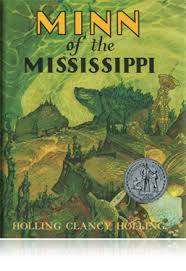Holling C. Holling
Listen to the Recess! Clip
| Author | Rita Smith |
| Air Date | 8/2/2005 |

Holling C. Holling Transcript
Holling C. Holling was a children’s author who used exciting narratives to teach nature and geography in large format picture books for children. Holling grew up roaming the woods of northern Michigan and read with interest the books about nature, Native Americans and camping that his mother brought him from the public library. He began to draw at age three and knew by the time he was a teenager that he wanted to write and illustrate books for children like those he had so enjoyed in his earlier reading life. To this end, he attended the Art Institute of Chicago, working primarily in black and white. Later, after spending a year studying in northern New Mexico where he became fascinated with the desert colors, he made color an important feature of his art. His best known work is a series of picture book travel tales including Minn of the Mississippi, the story of a snapping turtle and his journey from Minnesota to the Gulf of Mexico via the Mississippi River, SeaBird, which traces the travels of a bird carved from a walrus tusk, and Paddle to the Sea, his best known story, which describes the four year journey of a miniature wood carving of an Indian boy in a canoe from its starting point in Lake Nipigon, Canada, through the Great Lakes and the St. Lawrence River to its final destination in the Atlantic Ocean.
Each of these books contains a great amount of geographical detail wrapped in a compelling narrative enhanced with beautiful illustrations. The text fills the left hand side of the double page spread and is surrounded by black and white illustrations and hand-written notes which add historical, ecological or industrial explanations. The facing page is a large brilliant color illustration with the rich deep colors of forest, lake and river and wonderful manipulation of light and shade. Each book combines many areas of information with the techniques of fiction to produce a book that portrays a total pattern of life. Paddle to the Sea, for example, which was a Caldecott Honor book in 1941, includes information about the logging industry and how the logs are shipped and sawn; it illustrates the workers and people who live around the Great Lakes and the rivers and how they use them for both work and pleasure. It includes information on the great freighters that ply the waters, the beavers who build damns and the grouse, bears, watercress and lily pads that populate a northern marsh along Lake Superior. All of this information is woven seamlessly into the adventure of a little wooden canoe on its long journey to the sea. Holling was a master at portraying the deep down beauty and the inter-connectedness of all these elements: people, animals, land, lake, river, tree. The young reader goes on a great adventure and learns so much along the way.
Sources:
Children’s Literature Review, Deborah J. Morad, Editor. Detroit: Gale Research Company, Volume 50, 1999, pp. 44-48.
Holling, Holling Clancy. Paddle to the Sea, Boston: Houghton Mifflin Company, 1941.